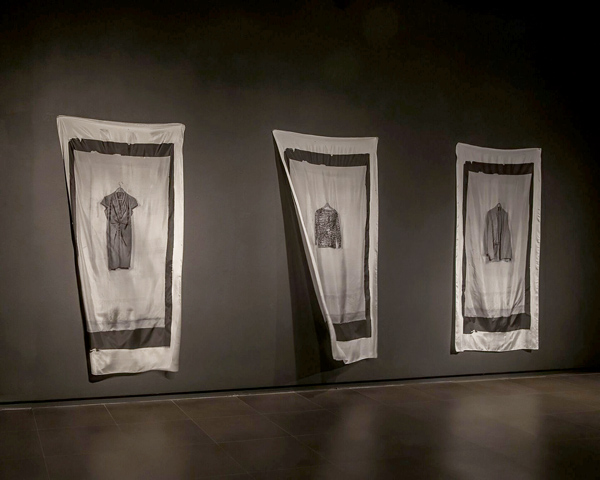What do we have when those closest and dearest to us pass away and what do we do with the things that were once theirs? Richard Turner’s installation Air Becomes Breath, 2017, takes that question on and has turned the clothing of his recently deceased wife, Sylvia, into the central element of his show. He has made these uninhabited garments into the hinge around which his installation literally swirls. In conjunction with her friends and their daughters, he has selected an exemplary set of secondary skins that her body would wear and then has turned them into elegiac black-and-white printed images on silk banners that fluctuate in the darkened space of the gallery.

installation view
The tones of black and white and grayscales communicate both the solemnity of the inspiration and its essential qualities. This grayscale also accentuates with its folds and draping the way clothing models and reveals, while covering the body. That the prints were made on a very fine silk doubles the folding and sumptuousness of the way in which attire cloaks and still reveals the body. Each of the photographic images is very simply isolated, hanging on what looks to be the same wooden hanger and situated in an open frame that is surrounded by the kind of black square that would have been the kind you would see an old photographic images done from a large negative. For someone who grew up in Italy, it is also reminiscent of the stark black bars surrounding the obituary notices that were regularly posted on the walls of small towns to communicate and commemorate those who have passed away. A Philip Glass musical work animates the gallery space and rotating fans keep the silk banners fluctuating in the movement of the wind, completing the installation.

installation view
Artists have long sought to create memorials and monuments that carry those who have passed away along with us into the present and future. More often than not, these artworks are made of solid earthy things, possibly in the hope of erecting a barrier against the onslaught of time. The task of celebrating and remembering the lives of the deceased is always a difficult but essential part of the arts. The eternal present of painting and the frozen moments of photography somehow keep the memory of those who are pictured there alive in a tradition of recalling their presence in our lives even after they have physically gone elsewhere. In Turner’s piece, the ephemeral quality of both the materials that are employed and the way that they are treated evokes both the sadness of life’s end, but also the inevitability of all life ceasing at one point. The exhibition is accompanied by a catalog in which these images and the thoughts of those who knew Silvia are passed on and become another trace into a future.
Ends November 9, 2017


